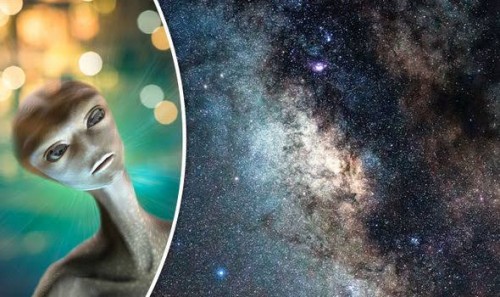Do aliens exist or are humans totally alone?
Stargazers have spent much of the past century trying to solve this conundrum and have made several unexplained observations along the way.
Once these puzzles are solved, we may have finally proved that aliens exist - or got one step closer to discovering that humanity is the only lifeform in the universe.
Of course, we won't know whether extraterrestrials are real until they get in touch with us or we find evidence of their existence.
And even if we do find alien life, it might be in the form of bacteria or other microorganisms, rather than fully fledged intelligent beings.
But that won't stop astronomers from looking.
We've collected some of the biggest unsolved space mysteries.
Is there life on Mars?
The Red Planet is a bit like Earth and is thought to have been covered with water at some point in its ancient history.Spaced out stargazers claim to have spotted all manner of weird things on Mars, from pyramids to alien bears.
But real scientists are no closer to discovering whether the Red Planet is actually a dead planet, or whether it once supported life.
It is thought Mars was frozen over roughly 3.8 billion years ago before warming periods melted the surface and created deep valleys and canyons.
A build-up of greenhouse gases in Mars’ dense atmosphere is thought to have sparked dramatic climate cycles.
Scientists believe this could by why the planet has water-carved features.
Water provides the conditions needed for life – so there could have been living organisms on Mars billions of years ago.
However, they could very well have been wiped out by the changing climate.
Is an alien megastructure orbiting a distant star?
In October last year, scientists offered a new theory to explain why a distant star called KIC 8462852, or Tabby’s Star, was displaying a bizarre “blinking” behaviour which caused its light to dim periodically.
One researcher made the serious suggestion that the light was being blocked by a huge object called a Dyson Sphere – a theoretical structure which could be built around a star in order to harvest its energy.
Last year, Jason Wright of Penn State University said the bizarre signals around Tabby’s Star looked like a “swarm of megastructures” and suggested they were “something you would expect an alien civilisation to build”.
“I can’t figure this thing out and that’s why it’s so interesting, so cool – it just doesn’t seem to make sense,” he told The Independent.
Other scientists have claimed the behaviour of Tabby’s Star could be caused by a swarm of orbiting comets which periodically block out its light or suggested it was the result of a complex phenomenon called "avalanche statistics".
Are aliens trying to contact us?
Scientist have picked up number of strange signals from distant stars in recent years. Whilst most of them probably come from natural sources, some signals may have been sent by aliens.
Last year, astronomers Ermanno F. Borra and Eric Trottier published a paper with the title "Signals probably from Extraterrestrial Intelligence" detailing the discovery of 234 signals.
The duo wrote: "We consider the possibility, predicted in a previous published paper, that the signals are caused by light pulses generated by Extraterrestrial Intelligence to make us aware of their existence."
Sadly, we're no closer to working out what aliens are trying to say - or whether they were actually saying anything at all.
Are extraterrestrials living in an ocean on Jupiter's moon?
Some scientists believe Europa, which is about the size of Earth’s moon, has an ocean hidden beneath its frozen crust.If the predictions turn out to be correct, this could be a great place to look for alien organisms.
“With abundant salt water, a rocky sea floor, and the energy and chemistry provided by tidal heating, Europa could be the best place in the solar system to look for present day life beyond our home planet,” NASA said last year.
The moon is thought to boast a huge global ocean containing twice as much water as Earth's oceans lurking beneath a layer of extremely cold and hard ice of unknown thickness.
NASA believes it has found evidence of water vapour plumes erupting off the surface of Jupiter’s moon.
Could these plumes contain traces of life that allow scientists to solve this space mystery?
Are we aliens?
Some scientists believe humans are the descendants of Martian life which was carried to Earth billions of years ago on an asteroid. Scientists believe life might have begin on Mars and then contaminated our own planet.
It’s believed life had a better chance of getting started on the now arid planet in ancient times because it used to have the right conditions for alien life – like water and a possible atmosphere.
They think that an asteroid collision caused by space rocks in our solar system smashing into each other might have caused a chunk of life from Mars to land on Earth.
Astronomer Caleb Sharf told Business Insider: “We can find pieces of Mars here on Earth and we suspect that there are pieces of Earth on Mars.
Are there any inhabitable planets near Earth and are they home to life?
Stargazers have already spotted several "exoplanets", which is the name given to planets outside our own solar system. Since its launch in 2009, NASA’s planet finding Kepler Spacecraft has discovered more than 4000 exoplanet candidates.
Of these, there have been 216 Earth-like located within the Goldilocks Zone — the region around a star in which the surface temperature of an orbiting planet might support water.
The problem is that while most of these Earth-like planets are habitable, they are located thousands of light years away, which means they are out of our reach.
However, astronomers recently found a “second Earth” capable of supporting life.
Astronomers at the European Southern Observatory (ESO) spotted an alien world orbiting Proxima Centauri — a red dwarf, a small low-mass star about 4.25 light-years from the Sun, which they called Proxima b.
They also found a world orbiting a nearby star 14 light years away, which may have an atmosphere that can support life.
European stargazers trained their telescopes on a planet called GJ 1132 b to discover that its blanketed by a thick atmosphere of “alien air”.

IT'S the biggest question in the universe and scientists are no closer to answering it.




